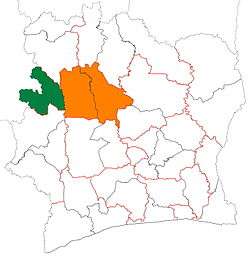Bafing Region
Bafing Region is one of the 31 regions of Ivory Coast and is part of Woroba District. The region's seat is Touba. The region's area is 8,922 km²,[4] and its population in the 2014 census was 183,047.[3]
Bafing Region Région du Bafing | |
|---|---|
| Motto(s): "La Renaissance du Bafing" | |
 Location of Bafing Region (green) in Ivory Coast and in Woroba District | |
| Country | |
| District | Woroba |
| 2000 | Established as a first-level subdivision via division of Worodougou Region |
| 2011 | Converted to a second-level subdivision |
| Regional seat | Touba |
| Government | |
| • Prefect | Benoît Yao Kouakou |
| • Council President | Diomande Lassina |
| Area | |
| • Total | 8,650 km2 (3,340 sq mi) |
| Population (2014)[3] | |
| • Total | 183,047 |
| • Density | 21/km2 (55/sq mi) |
| Time zone | UTC+0 (GMT) |
Departments and geography
Bafing Region is currently divided into three departments: Koro, Ouaninou, and Touba. The region is traversed by a northwesterly line of equal latitude and longitude.
History
Bafing Region was created in 2000 as a first-level administration region of the country. It was formed by splitting-off Touba Department from Worodougou Region. Koro Department was created as a split-off from Touba Department in 2008.
As part of the 2011 reorganisation of the subdivisions of Ivory Coast, Bafing was converted into a second-level administrative region and was added to the new first-level Woroba District.[5] No territorial changes were made to Bafing as a result of the reorganisation, but a third department—Ouaninou Department—was created by splitting Touba Department again.
Demographic change
| Year | 1988 | 1998 | 2010 | 2014 |
|---|---|---|---|---|
| Population | 107 886 | 148 813 | 205 339 | 183 047 |
Notes
- "Préfets de Région et de Préfets de Département (Conseil des ministres du mercredi 26 septembre 2012)", abidjan.net, 2 October 2012.
- "Bafing", gouv.ci, accessed 23 February 2016.
- "Côte d'Ivoire". geohive.com. Retrieved 5 December 2015.
- "Districts of Côte d'Ivoire (Ivory Coast)". Statoids.com. Retrieved 24 June 2015.
- Décret n° 2011-263 du 28 septembre 2011 portant organisation du territoire national en Districts et en Régions.
.jpg)